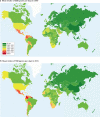The role of sugar-sweetened beverages in the global epidemics of obesity and chronic diseases
- PMID: 35064240
- PMCID: PMC8778490
- DOI: 10.1038/s41574-021-00627-6
The role of sugar-sweetened beverages in the global epidemics of obesity and chronic diseases
Abstract
Sugar-sweetened beverages (SSBs) are a major source of added sugars in the diet. A robust body of evidence has linked habitual intake of SSBs with weight gain and a higher risk (compared with infrequent SSB consumption) of type 2 diabetes mellitus, cardiovascular diseases and some cancers, which makes these beverages a clear target for policy and regulatory actions. This Review provides an update on the evidence linking SSBs to obesity, cardiometabolic outcomes and related cancers, as well as methods to grade the strength of nutritional research. We discuss potential biological mechanisms by which constituent sugars can contribute to these outcomes. We also consider global trends in intake, alternative beverages (including artificially-sweetened beverages) and policy strategies targeting SSBs that have been implemented in different settings. Strong evidence from cohort studies on clinical outcomes and clinical trials assessing cardiometabolic risk factors supports an aetiological role of SSBs in relation to weight gain and cardiometabolic diseases. Many populations show high levels of SSB consumption and in low-income and middle-income countries, increased consumption patterns are associated with urbanization and economic growth. As such, more intensified policy efforts are needed to reduce intake of SSBs and the global burden of obesity and chronic diseases.
© 2022. Springer Nature Limited.
Conflict of interest statement
V.S.M. is on a pro bono retainer for expert support for litigation related to sugar-sweetened beverages and has served as a consultant for the City of San Francisco for a case related to health warning labels on soda. There are no other financial or personal conflicts of interest to disclose that are related to the content of this paper. F.B.H. declares no competing interests.
Figures



References
-
- NCD Risk Factor Collaboration (NCD-RisC) Worldwide trends in body-mass index, underweight, overweight, and obesity from 1975 to 2016: a pooled analysis of 2416 population-based measurement studies in 128·9 million children, adolescents, and adults. Lancet. 2017;390:2627–2642. doi: 10.1016/S0140-6736(17)32129-3. - DOI - PMC - PubMed
-
- Dobbs R. et al. Overcoming obesity: an initial economic analysis. McKinsey Global Institute. https://www.sportanddev.org/en/article/publication/overcoming-obesity-in... (2014).
Publication types
MeSH terms
Substances
LinkOut - more resources
Full Text Sources
Medical
Research Materials

